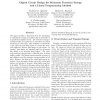Free Online Productivity Tools
i2Speak
i2Symbol
i2OCR
iTex2Img
iWeb2Print
iWeb2Shot
i2Type
iPdf2Split
iPdf2Merge
i2Bopomofo
i2Arabic
i2Style
i2Image
i2PDF
iLatex2Rtf
Sci2ools
VLSID
1999
IEEE
1999
IEEE
Digital Circuit Design for Minimum Transient Energy and a Linear Programming Method
This paper provides a theoretical basis for eliminating or reducing the energy consumption due to transients in a synchronous digital circuit. The transient energy is minimized when every gate has no more than one output transition per clock cycle. This condition is achieved for a gate when the gate delay equals or exceeds the maximum di erence between path delays at gate inputs. In practice, path delays are adjusted either by increasing gate delays or by inserting delay bu ers. The minimum transient energy design is obtained when no delay bu er is added. This design requires possible increases in gate delays to meet the minimum energy condition at all gates. However, the delay of the critical path may be increased. In an alternative design, where the critical path delay is not allowed to increase, delay bu ers may have to be added. The theory in this paper allows trade-o s between minimum transient energy and critical path delay. We formulate the problem as a linear program to obtain...
Delay Bu Ers | Gate Delays | Path Delay | VLSI | VLSID 1999 |
Related Content
| Added | 04 Aug 2010 |
| Updated | 04 Aug 2010 |
| Type | Conference |
| Year | 1999 |
| Where | VLSID |
| Authors | Vishwani D. Agrawal, Michael L. Bushnell, Ganapathy Parthasarathy, Rajesh Ramadoss |
Comments (0)

